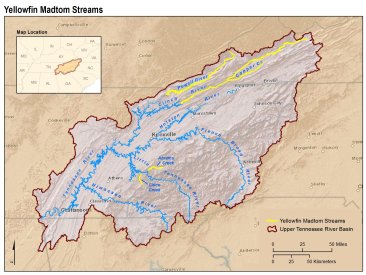A small, minnow-sized catfish tinged with yellow has made an encouraging comeback, taking again to creeks and small rivers in southwestern Virginia and eastern Tennessee where it was once common.

J.R. Shute, co-director of Conservation Fisheries, Inc., holds up a bag of yellowfin madtoms. Credit: Shane Hanlon/USFWS
The yellowfin madtom (Noturus flavipinnis) once thrived in the Powell River and Copper Creek, a tributary to the Clinch River. These bodies of water are among the most biologically diverse aquatic ecosystems in the nation.
By 1969, biologists thought the fish was extinct, lost to sedimentation and water pollution from agriculture and coal processing.
But then the fish was discovered at two locations in Virginia and Tennessee, and the Service listed the species as threatened under the Endangered Species Act in 1977.
The Virginia Department of Game and Inland Fisheries and a number of non-profit organizations support the U.S. Fish and Wildlife Service in efforts to recover the species. The VDGIF has used ESA funding to conserve the threatened fish. A state grant awarded in 2006 helped purchase conservation easements on two properties totaling 184 acres along the Clinch River—a project that reduced sedimentation and improve water quality to benefit the yellowfin madtom and seven federally endangered freshwater mussel species.
| Check out other stories of endangered plant and animal conservation in the Northeast – We’re sharing them throughout the year! |
Conservation Fisheries, Inc., a non-profit organization in Knoxville, Tennessee, has also helped restore the species by raising the species in captivity, reintroducing it into its historic range, and monitoring its status.
In 1986, Conservation Fisheries, Inc., began its captive propagation program for the yellowfin madtom. Fourteen years of raising and releasing fish paid off when snorkeling biologists discovered the yellowfin madtom at three new sites in the Powell River from 2000 to 2003. They even found non-tagged fish, documenting successful breeding in the wild. …Keep reading this story!


